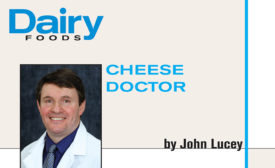Dairy Foods Columnists
Consumers’ perception of full-fat dairy products is changing as research gives a new appreciation for milkfat ingredients.
Read More
Processors, suppliers should keep watch for newly approved beneficial fibers
The FDA currently recognizes seven fibers as having health benefits. The new definition is evolving. Keep watch for newly approved beneficial fibers so you can adjust formulas and labels accordingly.
January 5, 2017
3-A SSI and the EHEDG work toward harmonization
3-A SSI and the European Hygienic Engineering & Design Group work to align standards specified for food processing equipment.
December 15, 2016
These are the top 3 drivers influencing dairy products in 2017
Consumers are buying whole (that is, natural) foods. They also seek nutrient-dense foods that are produced sustainably. Pay attention to these three factors and you should do well.
December 13, 2016
New label rule impacts vitamin, mineral claims
New nutrient Daily Values will impact milk’s perceived nutritional value. You may need to make changes to your dairy fortification policy.
December 9, 2016
Working together on dairy foods nutrition education can create greater impact
Be committed to elevating the health of children and adults through the pursuit of lifelong healthy eating habits with milk and dairy foods as a cornerstone.
December 7, 2016
Big ideas and bold leaders reap rewards in the dairy industry
Working together, we have brought together the many common interests of dairy processors and manufacturers in an effort to forge a better future.
December 6, 2016
Use these tools to measure sustainability efforts
To reduce GHG emissions further, all segments of the dairy industry must optimize efficiency. That means increasing milk yield per cow, reducing enteric emissions, improving manure handling, optimizing breeding and enhancing cow comfort.
October 11, 2016
Good sanitation can improve shelf life
Follow the four components that are necessary for effective cleaning. And then don’t forget to sanitize.
October 10, 2016
Understand the basics of Latin American cheese
The Latin American cheese market is growing. It’s important for cheesemakers to know the three distinct styles: fresh, melting and grating of these unique cheeses.
October 6, 2016
Stay ahead of the curve. Unlock a dose of cutting-edge insights.
Receive our premium content directly to your inbox.
SIGN-UP TODAYCopyright ©2025. All Rights Reserved BNP Media.
Design, CMS, Hosting & Web Development :: ePublishing














